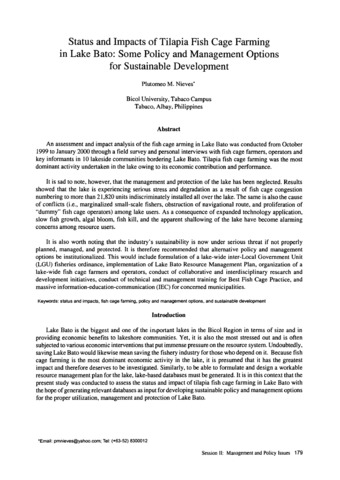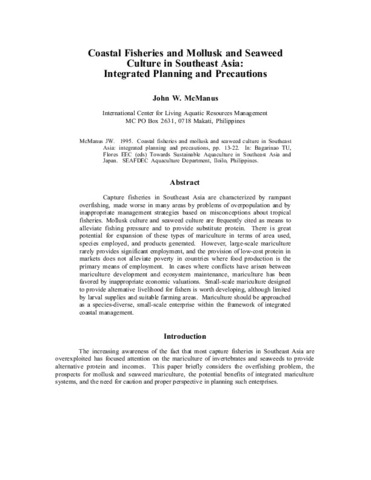Status and impacts of tilapia fish cage farming in Lake Bato: Some policy and management options for sustainable development
- Global styles
- MLA
- Vancouver
- Elsevier - Harvard
- APA
- Help

View/
Date
2005Author
Page views
2,038ASFA keyword
AGROVOC keyword
Metadata
Perlihat publikasi penuh
Share
Abstract
An assessment and impact analysis of the fish cage arming in Lake Bato was conducted from October 1999 to January 2000 through a field survey and personal interviews with fish cage farmers, operators and key informants in 10 lakeside communities bordering Lake Bato. Tilapia fish cage farming was the most dominant activity undertaken in the lake owing to its economic contribution and performance.
It is sad to note, however, that the management and protection of the lake has been neglected. Results showed that the lake is experiencing serious stress and degradation as a result of fish cage congestion numbering to more than 21,820 units indiscriminately installed all over the lake. The same is also the cause of conflicts (i.e., marginalized small-scale fishers, obstruction of navigational route, and proliferation of dummy fish cage operators) among lake users. As a consequence of expanded technology application, slow fish growth, algal bloom, fish kill, and the apparent shallowing of the lake have become alarming concerns among resource users.
It is also worth noting that the industry s sustainability is now under serious threat if not properly planned, managed, and protected. It is therefore recommended that alternative policy and management options be institutionalized. This would include formulation of a lake-wide inter-Local Government Unit (LGU) fisheries ordinance, implementation of Lake Bato Resource Management Plan, organization of a lake-wide fish cage farmers and operators, conduct of collaborative and interdisciplinary research and development initiatives, conduct of technical and management training for Best Fish Cage Practice, and massive information-education-communication (IEC) for concerned municipalities.
Suggested Citation
Nieves, P. M. (2005). Status and impacts of tilapia fish cage farming in Lake Bato: Some policy and management options for sustainable development. In M. L. Cuvin-Aralar, R. S. Punongbayan, A. Santos-Borja, L. V. Castillo, E. V. Manalili, & M. M. Mendoza (Eds.), Proceedings of the First National Congress on Philippine Lakes (pp. 179-192). Southeast Asian Regional Center for Graduate Study and Research in Agriculture (SEARCA).
Type
Conference paperISSN
1656-8099Koleksi
- LakeCon2003 [49]
Related items
Showing items related by title, author, creator and subject.
-
Coastal fisheries and mollusk and seaweed culture in Southeast Asia: Integrated planning and precautions
McManus, John W. (Aquaculture Department, Southeast Asian Fisheries Development Center, 1995)Capture fisheries in Southeast Asia are characterized by rampant overfishing, made worse in many areas by problems of overpopulation and by inappropriate management strategies based on misconceptions about tropical fisheries. ... -
Development and conservation of Philippine mangroves: institutional issues
The decline of Philippine mangroves from half a million hectares in 1918 to only 120 000 ha in 1994 may be traced to local exploitation for fuelwood and conversion to agriculture, salt beds, industry and settlements. But ... -
Mangrove conversion and brackishwater pond culture in the Philippines
Around 50% of mangrove loss in the Philippines can be traced to brackishwater pond construction. The decrease in mangroves from 450 000 ha in 1920 to 132 500 ha in 1990 has been accompanied by expansion of culture ponds ...





